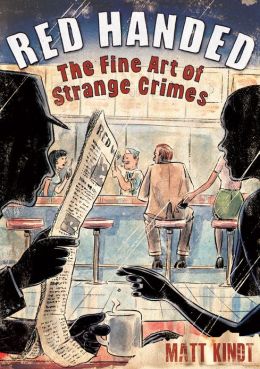 With a blurry slow pace, characters who tell their story and the philosophy about what’s right and wrong, Matt Kindt’s Red Handed graphic novel is unlike the typical detective story everyone expects. Kindt’s novel is a compilation of stories by criminals who just want to be understood and only to be busted by the much admired Detective Gould. Gould’s main goal is to find out where, why and how these weird crimes have come about his beloved city of Red Wheelbarrow.
With a blurry slow pace, characters who tell their story and the philosophy about what’s right and wrong, Matt Kindt’s Red Handed graphic novel is unlike the typical detective story everyone expects. Kindt’s novel is a compilation of stories by criminals who just want to be understood and only to be busted by the much admired Detective Gould. Gould’s main goal is to find out where, why and how these weird crimes have come about his beloved city of Red Wheelbarrow.
The main focus of the novel is divided into eleven different sections concerning each criminal and them speaking to the reader, using this opportunity chance to explain their case. They essentially establish a conversation with their reader as they try to gain compassion and acceptance.
With watercolor art and panels that resemble a newspaper, readers will find themselves reading the story as an article but analyzing like a real life detective. Readers can get lost in each individual’s life slowly. Some pages have no text and understanding can only come from the simplicity of the pictures.
But no reader will be bored when they’re snapped back into reality when Detective Gould busts their bubble and is seen on the front page of Red Wheelbarrow’s newspaper to give the official lowdown. Another interesting point of Kindt’s graphics is that there is contrasting variety. At the end of every chapter there is a black and white page with conversation between Detective Gould and the criminal. Readers’ eyes will be delighted between pastel colored flashback storylines and the striking sharpness that the detective brings in present reality.
Because there is no third person narrator and the detective is not the main character, these stories are not for a fast easy read. They take time to understand and accept since the only point of view the reader gets is the criminal’s. Readers will go back and forth on each panel, wondering how a seemingly innocent person becomes a troubled criminal for doing things with weird objects such as chairs, street signs and art pieces.
While Detective Gould has his own work cut out for him, so will the reader: they’ll have to figure out what each character has in common with each other and why they’re committing all these things in the same city. Kindt effectively makes a private investigator out of his readers since there are only introductions and no closures in each chapter.
And don’t think that the criminals are the only ones with personal problems; Kindt allows his readers to go behind the scene of Detective Gould’s life where he has his own cases to solve. As there are only three recurring characters in the novel, they have their own side plots at the end of every chapter. Both characters are women who are important in the detective’s life but it becomes the reader’s unofficial case to figure out how they are tangled with him and what exactly they want from him. With “Tess’s True Heart†and “the Detective’s Wife†readers will see a snippet of a newspaper column which will tell the feelings and current events in the lives of these two ladies.
Kindt’s ability to give each criminal their own time to demonstrate their humanity to the reader is much appreciated and unique unlike other mysteries. No longer will these people be seen as horrible city wreckers, but real people whose problems (loneliness, depression, desires) are illustrated through strange crimes. He successfully gets his readers involved in the story, attached to the characters and think about what the true meaning of justice is for one person may not be the same for anyone else.

Leave a Reply